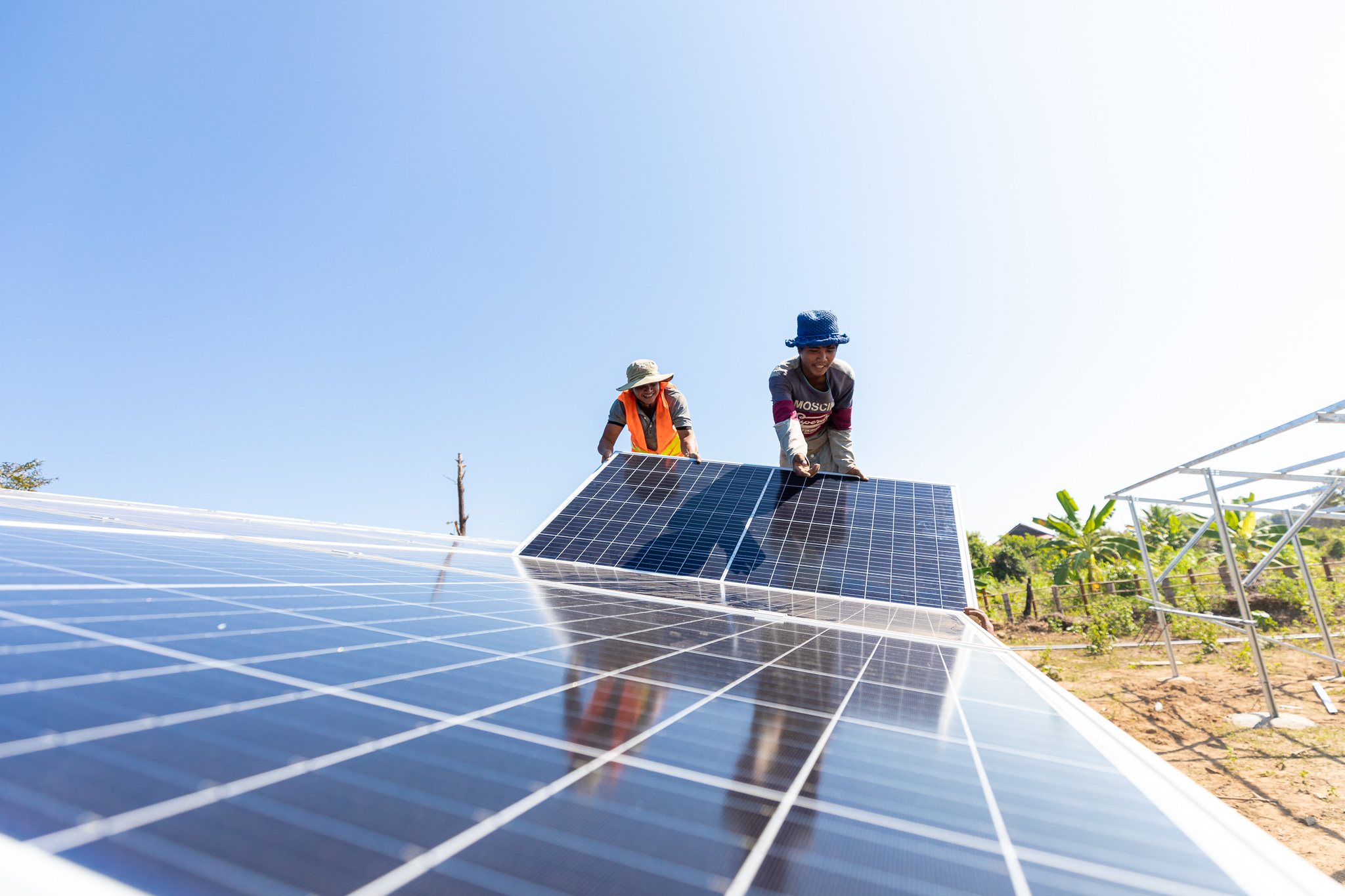Julien Chevillard, Chief Technical Advisor for the Cambodia Climate Change Alliance programme at UNDP Cambodia
How a remote Cambodian village became a beacon for sustainable energy solutions in the Mekong
January 24, 2023

Solar micro-grid installation
This piece is originally published on UNDP in Asia and the Pacific.
On a visit to Koh Kantheay on the Mekong, I hear residents talk about their expectations from the new solar micro-grid being installed in the village.
“We plan to have a rice cooker, this will reduce smoke and I will have time to do other tasks,” someone says. Others mention that they will no longer have to travel by boat to the mainland to have their battery charged. “I will be able to charge my computer to develop teaching materials and do some research,” says the local school-teacher. The list goes on. Their village sits on an island 70km South of Phnom Penh and right in the middle of the great Mekong river. It is one of the 245 “last frontier” Cambodian villages with no connection to an electricity grid. Designing viable models to deliver grid electricity in these locations –the most remote and hard-to-access – is no easy feat.
At the request of the Ministry of Mines and Energy (MME), UNDP has stepped in to help. For us, this is putting the UN’s motto of “leaving no one behind” in practice. Communities living in these villages are among the most vulnerable in the country, with limited access to public services and markets.
As I stand watching workers checking the alignment of the solar panels in the pale winter sun, it is time to reflect on the journey that got us here.
Koh Kantheay island is the first site for these micro-grids we plan to replicate across 244 villages. It is the result of a broad effort involving the ministry, the regulatory agency, the national electricity utility company, private energy entrepreneurs, local communities and UNDP. The strong partnership between UNDP and MME was the first step on our journey, and a prerequisite to get all the relevant partners around the table.
Other critical components of our approach included UNDP’s capacity to combine policy advice with trials on the ground, understanding of the local context and the willingness to allocate the time and resources needed to systematically work through the issues, in order to build something sustainable. This meant staying clear of the traditional approach where you just deliver a blueprint, build micro-grids, claim victory and move on. We went through a process of trial and error over several years, supporting MME to prototype models with different technologies and management arrangements, to monitor the issues that came up during the operation of these grids, and to look into the financial sustainability of various public-private partnership models.
Then came the negotiations on the level of public subsidy required, as well as legal and licensing arrangements that the regulators could sign up to. Here, transparency on financial aspects and the capacity to build trust between public and private actors was essential. “We had wanted to connect this village for some time, but without public subsidies, it was just too expensive,” says Chhay Soly, 54, the technical lead for the electricity enterprise developing the Koh Kantheay micro-grid.
So, you might ask, what does our final recipe for this innovative model look like? A 70% public subsidy for the initial infrastructure, and an additional operational subsidy to keep tariffs at affordable levels. Licensed energy entrepreneurs are responsible for co-financing 30% of the infrastructure, for operating and maintaining the micro-grid, and for providing electricity to the local school and community hall. Local communities have partial ownership of the assets and serve in the oversight committee for the micro-grid operation.
A few take-aways from me:
First on a personal note, this type of programme is the reason why I chose development work in the first place. Understanding local contexts, uncovering what drives people and organizations with different goals and constituencies, and finding innovative ways to align these interests to deliver on the Sustainable Development Goals. Reassuring to see that I’m in the right place.
Second, this model is one of several cases I have worked on this year in our climate change portfolio, where public-private-community partnerships are key to delivering on the SDGs for the most vulnerable. We have supported such a partnership for resilient access to drinking water, and we are considering a similar model for clean cooking solutions. I feel UNDP has a critical role to play in that space, helping to develop, test, broker and finance these innovative models.
Looking at the year ahead, I am also well aware of the work that still lies ahead. We need impact at scale. For our micro-grid program, this now means financing. In this blended finance model, we already have co-financing from the private sector, and an operational subsidy from the Government’s Rural Electrification Fund. We still need US $25 million in grants to subsidize a portion of the infrastructure costs in all remaining villages.
Finally, listening to Ny Srey, 55, discussing the size of the fridge that she could run, and how this could help her expand her small grocery business, I am reminded of the multiplier effect that such programmes can have if we build strong linkages with other areas of UNDP’s work. MSME development, women’s empowerment, digital solutions… I am sure 2023 will be full of opportunities, for Koh Kantheay island, and for UNDP. Happy new year!

 Locations
Locations